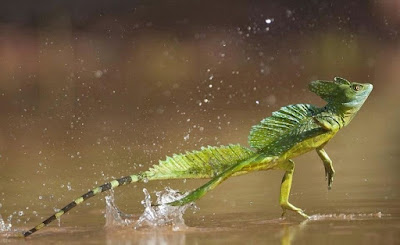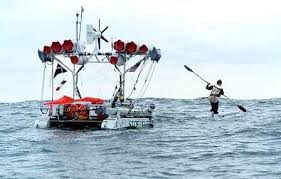To Run on Water

Green Basilisk Lizard running on water. Photo courtesy: Amazopedia
In the Animal Kingdom, swimming is a pretty common ability, while water running is downright uncanny. Of the more than 1,200 animal species that walk on water, large animals make up the minority. Today, we’ll investigate the anomalous basilisk lizard as an example of a mid-weight water runner, explore the physics behind its motion, and determine what it would take for humans to hone such skills.
What is a Basilisk Lizard?
Basilisk lizards (Basiliscus plumifrons) are a group of reptilian omnivorous, tropical organisms that are closely related to iguanas. Green basilisk lizards grow up to two feet in length and seven ounces in mass. Males have a distinctive tall crest adorning their heads and backs used to attract females. Their diet consists primarily of plants, insects, fruit, and small vertebrates. Predators include snakes and birds. To evade predators, basilisk hatchlings are born capable of land and water movement, climbing, and swimming. Like humans, they are capable of bipedal motion (walking on two legs). Their common names include the plume basilisk, double-crested basilisk, and Jesus lizard.How do Basilisk Lizards run on water?
Basilisk lizards use a three-part system to support their weight while running on water. Running begins with a step. As the lizard swings its foot through the air, it quickly slaps downward onto the water’s surface. This forceful slap pushes down against the water, causing the water to react with an equally powerful push upwards. Up goes the lizard, as the water lifts it into the air.To increase its lift, the lizard pushes its foot further down into the water, creating an air cavity between itself and the water. As the water rebounds against the foot and air cavity, the lizard is propelled further upwards, adding to its initial lift.
Imagine jumping on a trampoline. The harder you jump, the higher you go. Jumping straight up and down further improves your height. In the ideal jump, your whole foot hits the trampoline’s surface, leading you to be propelled directly upward. Basilisk lizards slap as hard as they can, with their feet angled vertically. When they stroke the water, they bounce. Just like in humans, the lighter the lizard, the easier it is to be lifted into the air, and therefore to stay afloat.
As the lizard is boosted into the air, it pulls its foot out of the water and into the air bubble, created by the splashing water. With a quick curl of the toes, the lizard appears to glide above the surface, prior to taking another step. Such pirouettes are not only graceful, but also prevent drag, allowing the lizard to maintain its rapid pace. For further speed and forward momentum, basilisk lizards pump their arms contralaterally, or in opposition to the stepping leg. Like a track athlete, the left leg extends to take a step, while the right arm accompanies it. When the arm swings forward, the leg moves down; when the arm pumps backward, the leg raises. Throughout the process, the tail acts as an extension of the body, following the motion and capitalizing on momentum when possible.
Water running isn’t completely uniform, however. It is common to see differences in arm position depending on water running style, lizard body, and skill. Differences in leg technique are also common. Like gymnasts, some basilisk lizards push from the sides of their feet, decreasing jump heights and slowing speed, while others aim for power and full foot contact. These disparities may be tied to balance. In humans, lower jumps and grounded steps usually help stability. Perhaps, lateral foot rotation results in stable and slow running. Alternatively, differences in anatomy and, more specifically, leg structure may hinder running posture. After all, its difficult to create an ideal body that allows for quadrupedal (4 legged) and bipedal (2 legged) motion.
Could humans run on water?
Yes, but we would need an incredible amount of speed, very specific conditions, or additional equipment.Speed Walking— Paradox or Malapropism
Humans sink because our bodies are denser than water. There are more molecules tightly packed into human bodies than there are in liquid water. To avoid sinking, we must either lower our densities (make ourselves less compact) or create enough force to combat our weight (balance our propensity to sink with lift).
Changing our densities doesn’t quite work. Unfortunately, can’t stretch ourselves apart, without serious injury and loss of function. Although tempting, we also cannot fill ourselves with enough low-density gas (air or some alternate combination) to float completely above water, at least, not without serious biological consequences. We could change the density of the liquid that we attempt to walk on, but that would probably disqualify it as water.
The remaining solution is to alter our speed, and therefore force. To eliminate the issue of sinking, a person would need to generate enough vertical thrust (force upward) to cancel out any downward motion. We can approximate this thrust as equal to the weight of the runner. Since weight is the amount of downward force on our runner, an equally strong upward thrust, or lift, would make us neutrally buoyant. Welcome to motion-less floating.
To produce forward motion, the runner would need to push down and backwards against the water upon each step. Assuming normal human proportions, a 155lb human with size 9 shoes would need to run at a minimum of 10 meters per second to water “walk” for about 2 seconds. For sustained running, 30m/s speeds would be necessary. This brings up several limitations:
Alternatively, if the runner wore large, rigid fins, the person could safely run on water on the moon— assuming the fins fit on a standard spacesuit. Earth however, would still be an impossibility, as fins make runners slower, and gravity would pull the person underwater. Attaching a large, taught suspension cable to the person would sufficiently facilitate water walking on earth, but surely that’s cheating.
Changing our densities doesn’t quite work. Unfortunately, can’t stretch ourselves apart, without serious injury and loss of function. Although tempting, we also cannot fill ourselves with enough low-density gas (air or some alternate combination) to float completely above water, at least, not without serious biological consequences. We could change the density of the liquid that we attempt to walk on, but that would probably disqualify it as water.
The remaining solution is to alter our speed, and therefore force. To eliminate the issue of sinking, a person would need to generate enough vertical thrust (force upward) to cancel out any downward motion. We can approximate this thrust as equal to the weight of the runner. Since weight is the amount of downward force on our runner, an equally strong upward thrust, or lift, would make us neutrally buoyant. Welcome to motion-less floating.
To produce forward motion, the runner would need to push down and backwards against the water upon each step. Assuming normal human proportions, a 155lb human with size 9 shoes would need to run at a minimum of 10 meters per second to water “walk” for about 2 seconds. For sustained running, 30m/s speeds would be necessary. This brings up several limitations:
- Our feet are small and compact. The theoretical runner could only push about 7lbs of water per foot. More than that, and their foot would drag and sink, resulting in a large belly flop. A circular foot, with an area of 3 feet squared, would do a much better job on water, but good luck walking on land.
- Water reacts to force. After the first step on water, the runner would have to press against forward moving water. This would require even more force to instill forward momentum and avoid drag. Therefore, the runner would have to either accelerate with each step, or begin water walking with a speed likely over 20m/s. Even this approach would only work for several seconds.
- Humans are too slow for this exercise. The fastest men in the world sprint at roughly 10.5m/s. Any faster would be nearly impossible. Even under perfect circumstances, we can safely say this would constitute water running, rather than walking.
Alternative Conditions
If instead our hypothetical person wished to walk by relying on the water’s surface tension (like a water bug), rather than his own strength, the runner would need feet with a perimeter of about 6 miles, rendering them a bipedal blob with no shoes. In all likelihood, assistive equipment would work much better than impossible speeds and magnanimous feet.Alternatively, if the runner wore large, rigid fins, the person could safely run on water on the moon— assuming the fins fit on a standard spacesuit. Earth however, would still be an impossibility, as fins make runners slower, and gravity would pull the person underwater. Attaching a large, taught suspension cable to the person would sufficiently facilitate water walking on earth, but surely that’s cheating.
A Brief History of Assistive Materials
While fins and spacesuits may not realistically keep water runners from sinking, inventors have worked for centuries to accomplish the near godly task. These three inventors have changed the landscape of artificial water walking:
“Skis With Which One Can Walk On Water” by Leonardo da Vinci. Photo Credit: Leonardo da Vinci Complete Works
Yoav Rosen Walking on Water. Photo Credit: WaveWalk
International records point back to 1988, when French entertainer Remy Bricka walked across the Atlantic on a pair of floating skis for 59 days. This record carries skepticism however, because Bricka used not only his legs, but also a paddle, to propel himself forward. The resulting posture resembled today’s paddleboarders— maybe Bricka was onto something… Anyone up for paddle skiing?
Remy Bricka “Walking” Across the Atlantic, June 5, 1988. Photo Credit: Deseret News
Where Humans Stand
Today, mimicking the basilisk lizard is yet to be accomplished. Mankind’s most effective water walking inventions allow for slow escapes with frequent resting periods. To truly master the art, well, we need some major ideas.Do you have an invention for water walking? What other animals walk on water? Would blob feet suit you? What should I write about next?
Leave you answers in the comments section below. Share if you know a basilisk lizard.
© 2020 Sabrina L. Groves. Creative CommonsAttribution-Noncommercial 4.0 International License.







Comments
Post a Comment